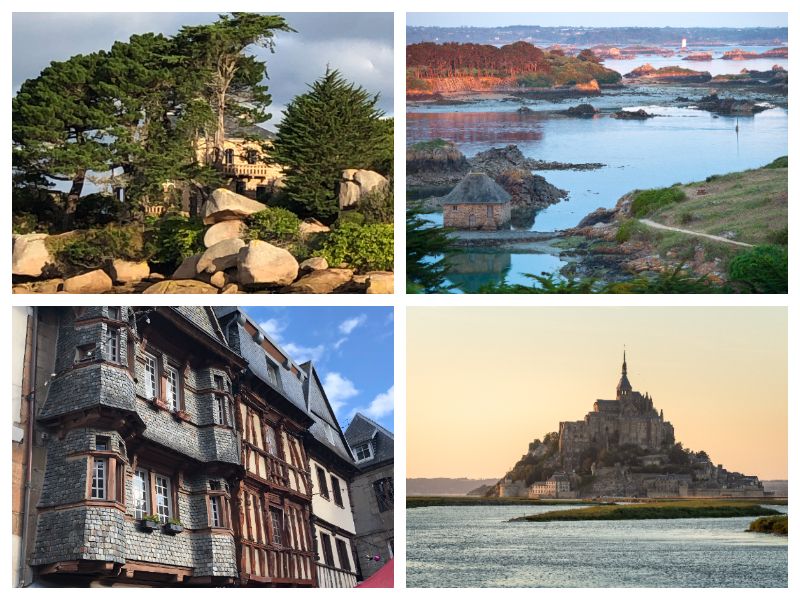For a 14-day holiday in the Côtes-d'Armor

What to visit in the west of the Côtes-d'Armor
Plouha has the highest cliffs in Brittany. They rise to a height of 104 metres. → From Palus beach, take the GR34, the old customs officers' path. Enjoy breathtaking views of Saint-Brieuc Bay. → Continue on your way to discover
- The picturesque beach of Gwin Zégal with its tree trunks jutting out of the water. This mooring port dates back to the 5th century.
- The bay of Anse Cochat, renamed Bonaparte Beach, its code name during the Second World War. Shelburne Network.
- Pointe de la Tour
- The cove of Bréhec Inland, you will find the chapel of Kermaria-an-Iskuit. This chapel is famous for its 15th-century frescoes depicting a danse macabre. Seven paintings range from the highest dignitaries to the poorest. ‘All are equal in death.’ Find out more about Plouha
Saint-Quay-Portrieux: a seaside resort dating back to the early 19th century
- Casino Beach: a beach with a seawater swimming pool that fills up at high tide
- Portrieux lighthouse
- Pointe du Sémaphore: viewpoint over Saint-Brieuc Bay
- Calan Castle
- Île de la Comtesse: accessible at low tide
- Moulin Saint-Michel: restored mill offering a glimpse into local history.
- Notre-Dame de la Garde Chapel: historic building with original architecture and a rich maritime history
1 -Bréhat Island is nicknamed ‘the flower island’ because its mild ocean climate is ideal for flowers such as agapanthus and hydrangeas, as well as tropical plants and trees. → Departures from Pointe de l'Arcouest in Ploubazlanec (Paimpol) every day except in low season (check dates) → From the Saint-Quay-Portrieux pier. Port d'Armor, passenger pontoon opposite the harbour master's office. Tuesdays and Thursdays. Check with the Saint-Quay-Portrieux tourist office.
- The Bréhat glassworks in the old citadel
- The Birlot tide mill
- Saint-Michel Chapel and the Croix de Maudez
- Anse de la Corderie
- Paon Lighthouse
- Guerzido Beach
- Bréhat tree nursery.
2 - Paimpol and its fishermen on the high seas off Newfoundland and Iceland.
- Its town centre and amateur houses
- Beauport Abbey,](https://abbayebeauport.com/fr/index.html) a 13th-century maritime abbey covering 120 hectares. Events are held throughout the season.
3 - Le Sillon de Talbert is a strip of sand and pebbles that juts out 3 km into the sea. It is a protected natural site (no dogs allowed). → Head towards Paimpol, the Lézardrieux bridge and Pleubian.
4 -In Lézardrieux, on the road to Pontrieux, visit the Domaine de La Roche Jagu and its medieval-inspired garden.
5 - Pontrieux, a small town of character, is known for its wash houses and half-timbered houses. You can take a boat trip along the river. If you want to discover the Trieux and its estuary in a different way, hop aboard the Passeur du Trieux.
6 - Plougrescant is known for its Gouffre house, nestled between two rocks. An iconic site with wild and unspoilt landscapes. I love it! → Head towards Paimpol, Lézardrieux, Tréguier and Plougrescant. Allow 50 minutes.
7 - Tréguier, a charming Breton town in the Côtes-d'Armor, will charm you with its rich heritage and medieval atmosphere.
- Saint-Tugdual Cathedral and its magnificent cloister
- The bishop's palace, a building that bears witness to the town's religious past
- Its half-timbered houses and picturesque narrow streets
- The house of the writer Ernest Renan
8 - The Pink Granite Coast reveals unique landscapes in shades of pink. Spectacular at sunset. Between Perros-Guirec and Ploumanac'h, its rocks sculpted by the elements offer a fascinating backdrop.
- Perros-Guirec: a renowned seaside resort with superb beaches and the famous customs officers' path.
- Ploumanac'h: known for its pink granite rocks with surprising shapes and its iconic lighthouse
- The Sept-Îles archipelago: a bird sanctuary home to thousands of seabirds.
- Trégastel: its beaches and marine aquarium
- Trébeurden: a charming coastal village with spectacular views.
- Costaérès Castle: a picturesque residence nestled on a rocky islet.
- The Brittany Planetarium: ideal for a fascinating discovery of astronomy.
9 - The Valley of the Saints: a unique site with its monumental statues.
What to visit east of the Côtes d'Armor
10 - Cap Fréhel and Fort Latte are two jewels of Brittany's Emerald Coast.
- Cap Fréhel offers spectacular cliffs towering over the sea at a height of over 70 metres. This unspoilt natural site is a bird sanctuary. Its iconic lighthouse adds to the charm of the landscape.
- Fort La Latte, also known as the Château de La Roche Goyon, is a medieval fortress perched on a rocky promontory. A hike along the coastal path (GR 34) connects these two sites, offering breathtaking views. This is a must-do walk for nature and heritage lovers. → Head towards Saint-Brieuc, Pléneuf-Val-André and Cap Fréhel. Allow an hour's drive.
11 - Dinan is a magnificent medieval town in Brittany, on the banks of the Rance. Surrounded by ramparts, it offers a journey back in time with its cobbled streets, half-timbered houses and imposing 14th-century castle. → Head towards Saint-Brieuc, Lamballe, Jugon les Lacs and Dinan. Allow 1½ hours.
12 - Dinard, located on Brittany's Emerald Coast, is an elegant seaside resort renowned for its Belle Époque villas and chic atmosphere. Dinard is famous for its British Film Festival, which takes place every year in September.
13 - Saint-Malo, a former pirate town, was the birthplace of famous sailors such as Jacques Cartier. Its historic centre, Saint-Malo intramuros, offers a fascinating stroll through cobbled streets and fortifications.
14 - Mont-Saint-Michel, located in Normandy, is one of France's most iconic sites. This medieval village perched on a rocky island is famous for its majestic abbey, picturesque streets and spectacular views of the bay.







